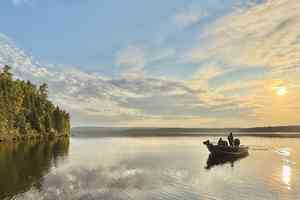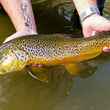I drove along the South Fork of the Snake this past weekend on my way to do a quick repair to my daughter’s truck over in Grand Teton National Park, and the river is cruising. In fact, every creek and stream we drove over was bursting with full-on spring runoff.
A weekend of cold rain really got the snowmelt moving, and, while everything is green and glorious, the moving water in my stretch of the Rockies will make fishing a bit more challenging for at least a few more weeks.
But, for die hards who need to be on the river—and believe me, I know how you’re feeling—there are some tried-and-true fly patterns that work pretty well during runoff, when water is high and murky. The fish are still there, and they’ll be pushed off to the slower water along the banks, in softer side channels and behind cover, just to avoid the worst of the flows.
The key during high water is to get your fly deep, and make sure it’s conspicuous—visibility, even for fish, is pretty dismal when rivers are pumping season’s worth of melted snow out of the mountains. And, consider the timing—spring is a season of rebirth. Stoneflies are a couple weeks from busting out on some of the West’s fabled trout streams that now find themselves in the throes of high water. Rainbows and cutthroats spawn this time of year, which puts eggs in the water. And, thanks to sloughing banks and fast water, worms that live in the earth often find themselves suspended in muddy rivers, where trout lie in wait.
With all that in mind, give these patterns a shot:

The Girdle Bug
This is my favorite big nymph, and not just because it’s easy to tie (and it is!). Its wiggly rubber legs move water, and with some weight, it’s a great, but admittedly impressionistic, imitation of big stonefly nymphs that get caught up in the current during runoff. Fish it deep under an indicator, or weight it a bit and high-stick it through slow, deep runs. Often, I’ll “jig” a Girdle Bug a bit, and, surprisingly, the hits often happen on the way up.
Also, Girdle Bugs are good year-round searching patterns, particularly when nothing is hatching. On my favorite stretch of the South Fork each fall, after flows drop and side channels become wadable, I’ll start with a Girdle Bug and there are days when I’ll never change flies.

Egg patterns
This time of year, throughout the country, rainbow trout are spawning. In the West, throw cutthroats into the equation, too. Often, deluges of fresh runoff will push eggs off of their gravelly redds and into the current—these reddish-orange balls of protein are important to the diet of all trout, but it the spring, brown trout will often move quite a ways to take a drifting egg.
Many anglers turn up their noses at fishing egg patterns, but eggs are part of a trout’s natural diet. And there are any number of patterns out there that will do the trick, ranging from the much-maligned Glo-Bug to simple patterns tied with porcupine chenille over some (hopefully) lead-free wire.
And, of course, if you're planning on fishing eggs, the good, old Alaska-style pegged bead should always be a consideration when eggs are in the water. Yes, they work for big rainbows and Dolly Varden in the far north, and they work for fat browns on run-off swollen rivers, too. In fact, they're generally more effective than egg flies and kill far fewer trout.
And don’t forget the venerable Egg-sucking Leech—this streamer can be deadly stripped through high water.

Worms
One of the biggest springtime browns I ever caught was on a float through the Gunnison Gorge in May. Runoff was well under way, and the water was dirty. My guide for the day explained to me that the best chance for catching fish would be dredging a San Juan Worm up against the banks, and I’ll be damned if he wasn’t right.
Since then, I’ve used worm patterns whenever water levels rise, even after summer thunderstorms in high-mountain creeks and streams. It just makes sense — high water pushes against earthen banks and worms end up in the water. And we’ve all known since we were kids that trout eat worms, even if we ignore that reality as we mature into honest-to-God fly fishers.
Take a hint from your 12-year-old self and stick a few worm patterns in your fly box, especially this time of year.
Honorable mentions
Baitfish imitations, like Clousers and Deceivers, are often thought of as saltwater patterns, but during spring runoff, young trout and salmon often find themselves caught up in the current. Swinging a chartreuse-and-white or olive-and-white Clouser through slower runs during high water can produce your most aggressive strikes of the day.
When light is low in the afternoons or on cloudy days, think about patterns that you might otherwise leave at home, but might offer fish something solid to attack. A couple of years ago, we surprised ourselves on the lower Beaverhead on a blustery spring day by nabbing some truly big browns by stripping mouse patterns from bank to bank. The floating flies made just enough racket to get the fish to pay attention. We tried the mouse flies because, as we walked to the river, we couldn’t help but notice the little critters skittering underfoot as we pushed aside fresh green grass. It never hurts to match the “hatch,” right?
And don’t discount some of your tried-and-true trout streamers. Slumpbusters, Zonkers and ‘Buggers, with some added weight can and do work in high, murky water.
Runoff doesn’t mean fishing is off. Honestly, it will likely mean slower, more deliberate fishing, but many times, the rewards are greater than at any time of the year. Armed with the right flies and in the right water, an angler can have a great day fishing while everyone else is of the mind that the river is unfishable.






























Comments
Anonymous replied on Permalink
Great article. Water back East is still high also.
Nick Maricich replied on Permalink
Awesome thank you... just floated the lower Henry's Fork and big rubber legs were the ticket. Brown and black ones
Pages